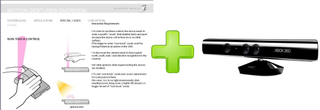Bringing Kinect and gesture control to Windows Phone

Going back to the Windows Mobile 7 rumor days in 2009, we can find lots of talk about gesture and non-touch control of the OS. Of course that was Windows Mobile 'Photon' which was scrapped and replaced with Windows Phone 7.
Flash forward to today and we still don't have much in the way of "non-touch control", though we do have accelerometers, compass, aGPS and other sensors (not to mention augmented reality). But Microsoft does not appear to be moving away from gesture control, which should be obvious to anyone familiar with their Kinect sensor for the Xbox (and eventually PC). Having received a Kinect recently as a gift, we can say that the technology in the Kinect is as "alien" as anything we've seen. However, it's still a foot long device which is much bigger than even an HTC HD7.
In 2010, Microsoft bought a company called Canesta who specialize in gesture control technology, specifically chip making. The idea is that eventually this company will be able to shrink down the Kinect chip to a centimeter., From EE Times:
"Canesta’s engine is said to outperform the PrimeSensor which Microsoft is currently licensing from PrimeSense Ltd. (Tel-Aviv, Israel) for its Kinect. When Microsoft commercializes the Canesta-invented chip-level work-alike of the PrimeSensor, it will be able to downsize the foot-long Kinect to about a square centimeter, enabling tiny robots and other mobile devices, such as the Windows Phone, to perform sophisticated gesture recognition for natural user interfaces, autonomous navigation and many other tasks."
Hearing that of course brings us back full-circle to those 2009 rumors of non-touch control and a mobile phone. Perhaps Microsoft was ahead of itself at the time, but it's becoming obvious that in the near future, such technology shrunken down to our phone will be a reality. And considering how Microsoft is quite a bit ahead of Google and Apple in terms of gesture recognition/control, they're positioned for great things in the mobile world. In fact, according to the NY Times, Microsoft may have a lock on this technology:
Last year, Microsoft acquired 3DV systems, a company with similar gesture recognition technology. That deal coupled with the Canesta purchase may prevent competitors from acquiring these 3-D abilities and cut off potential intellectual property squabbles. Canesta has secured 44 patents in this area and has more pending.
Anyone else think Microsoft is a sleeping beast?
Get the Windows Central Newsletter
All the latest news, reviews, and guides for Windows and Xbox diehards.

Daniel Rubino is the Editor-in-chief of Windows Central. He is also the head reviewer, podcast co-host, and analyst. He has been covering Microsoft since 2007, when this site was called WMExperts (and later Windows Phone Central). His interests include Windows, laptops, next-gen computing, and watches. He has been reviewing laptops since 2015 and is particularly fond of 2-in-1 convertibles, ARM processors, new form factors, and thin-and-light PCs. Before all this tech stuff, he worked on a Ph.D. in linguistics, watched people sleep (for medical purposes!), and ran the projectors at movie theaters because it was fun.
